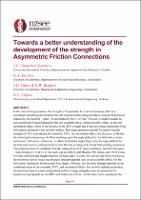Towards a better understanding of the development of the strength in Asymmetrical Friction Connections (AFCs)

Download
Date
2020-04-22Authors
Chanchi Golondrino, Jose Christian
MacRae, Gregory Anthony
Chase, James Geoffrey
Rodgers, Geoffrey
Clifton, G. Charles
Metadata
Show full item recordAbstract
In the current design practice, the strength of Asymmetric Friction Connections (AFCs) is calculated considering the friction force developed at both sliding interfaces using the bolt tension reduced by the moment – shear - axial interaction (MPV) effect. However, available models do not consider the friction induced by the bolt assembly force, termed assembly effect, or the bolt inclination effect, which is the increase in the AFC strength due to the horizontal component of the bolt tension produced when the bolt inclines. This paper proposes a model for quantifying the strength of AFCs considering the assembly, MPV, and inclination effects for the cases: i). Before the slotted plate breakaway, ii). Bolts inclining up to the angle defined by the bole hole oversize and termed bolt elastic inclination, iii) Bolts inclination angles larger than the angle defined by the bole hole oversize and produced by bolt flexural yielding and termed bolt yielding inclination. The proposed model is validated from the testing of an AFC scaled prototype, and from the quasi – static testing of 18 AFCs in real scale and assembled with Bisalloy 500 shims, and 2 M16 Grade 8.8 bolts with bolt grip lengths between 52.5mm and 172.5mm. It is shown that before breakaway the hysteresis loop is linear, and the peak strength depends only on the assembly effect. For the bolt elastic inclination, the hysteresis loop shape is bilinear, and the peak strength depends on the combined action of the assembly, MPV, and inclination effects. For the bolt yielding inclination, the hysteresis loop is square and pinched and the average strength across the plateau of the hysteresis loop depends on the MPV and inclination effects. For the three cases considered, the proposed model predicts the AFC strength with accuracies of 76% – 120%. The proposed model shows the horizontal component of the bolt tension from the bolt inclination effect was 6% - 28% of the AFC strength for the bolt elastic inclination, and 38% - 53% of the AFC strength for the bolt yielding inclination.
